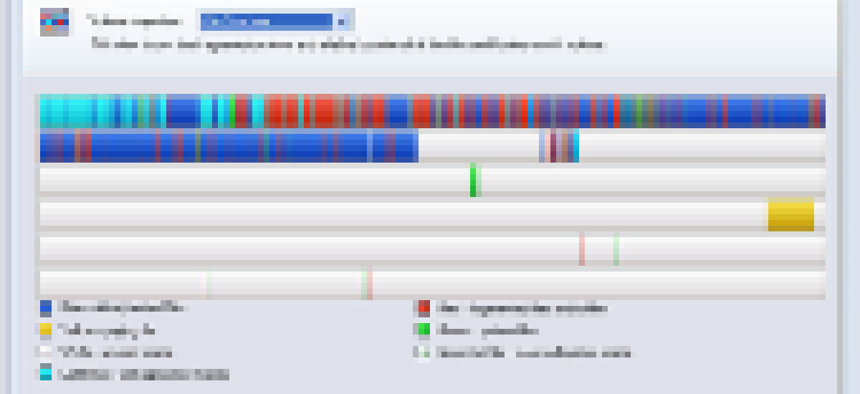Defragging files without having to do a defrag


Connecting state and local government leaders
The GCN Lab looks at Diskeeper's latest in disk defragmentation technology, which prevents the fragmentation of files by changing how disk space is allocated. One result: Manual defrags will be fewer and further between.
We’ve been covering disk defragmentation technology, and Diskeeper specifically, for more than a decade. Every year, Diskeeper has been able to improve scan times and make the sometimes painful process of keeping drives clean a little easier. So this year, we were expecting about the same performance, but perhaps a little better, faster or cheaper.
We didn’t expect Diskeeper 2010 to actually get to the heart of the matter and fix the inherent problem with Windows operating systems that creates fragmented files in the first place. That might be a bit of an exaggeration, but it is essentially what Diskeeper has done. It’s all part of the company’s new IntelliWrite technology.
In a nutshell, when PCs write files to their drives, they leave open a little space in case that file needs to expand. The trouble is that, for most files, it’s too little space for the job. When those files need to grow, such as when you add data or they somehow change, they quickly use up that extra space. The computer doesn’t really care; it simply writes the rest of the file on a space somewhere else on the disk that isn’t physically near the first part of the file, thus creating a fragment. If this process happens again and the newly allocated space runs out, it could mean a third file fragment is put somewhere else. Hence, files and disks can become heavily fragmented over time.
Diskeeper 2010 Professional
Pros: Automatically fixes files before they become fragmented; real-time monitoring.
Cons: A couple of things about the new interface could be simpler.
Performance: A
Ease of use: B+
Features: A
Value: A+
Government price: $59.95
The Diskeeper 2010's solution is to create a driver that overrides the standard system of allocating drive space. And what IntelliWrite does is allocate more space for files. That does not come without a cost. Using IntelliWrite requires about 2G of extra drive space. But space is cheap these days, and most people are probably willing to use that space for increased system performance.
Beyond that, you still get the normal defragmenting ability that most users have come to expect from Diskeeper. With Diskeeper 2010, using IntelliWrite is optional, though we would highly recommend it.
We took a desktop PC in the lab that hadn’t been cleaned in a long time, one of a pool of systems we specifically don’t wipe between reviews so that we can test products such as this one, and ran performance benchmarks. According to the Passmark Performance 7.0 benchmark testing (www.passmark.com), the system in question got an overall score of 300.6 and a disk performance mark of 202.4. Those scores are mostly used for comparison purposes with other systems but, in this case, were used for comparison with itself before and after running Diskeeper.
After we installed Diskeeper 2010 Professional and ran a hard defrag, the overall performance went up to 311.8 and the disk performance shot up to 218.1. That means you might be able to notice files opening a little more quickly overall and probably will be able to see the difference when loading files from the hard drive.
But the real strength of Diskeeper 2010 will probably be felt over time. The interface shows how many files, as a percentage, have been defragged with IntelliWrite versus how many were patched back together using the normal defrag process. At first, it will likely be close to 90 percent in favor of the manual defrag, as ours was. But over time, as files are written, IntelliWrite will quickly catch up, keeping the drive clean so that a manual defrag might not be needed often, if at all.
The one minor complaint we have is that the program interface is a little cluttered. When you click on the button to do a manual defrag, a pop-up window appears that shows the colorful representation of file health on the drive. But this window sits over the status window that tells you how the process is going. So you don’t know how long the defrag will take or if the program is doing anything at all until you close that window. In addition, it shows you in real time — as a moving graph — how much of your system resources Diskeeper 2010 is taking up and how many files IntelliWrite is saving from defrag.
In the case of the former, that chart is taking up valuable resources. In the latter case, the graph is almost always going to be at zero if you are looking at the IntelliWrite interface and not writing files to your drive.
Diskeeper 2010 Professional is available for $59.95. You can add HyperFast to that, which optimizes solid-state drives, for a total cost of $69.95. And you can get the server version of the program for $349.95.
We would again highly recommend Diskeeper 2010 for keeping almost any system running at peak performance. And you don’t even have to run the defrag process very much.
Diskeeper, 800-829-6468, www.diskeeper.com
NEXT STORY: Sensors warn of soldier brain injuries




